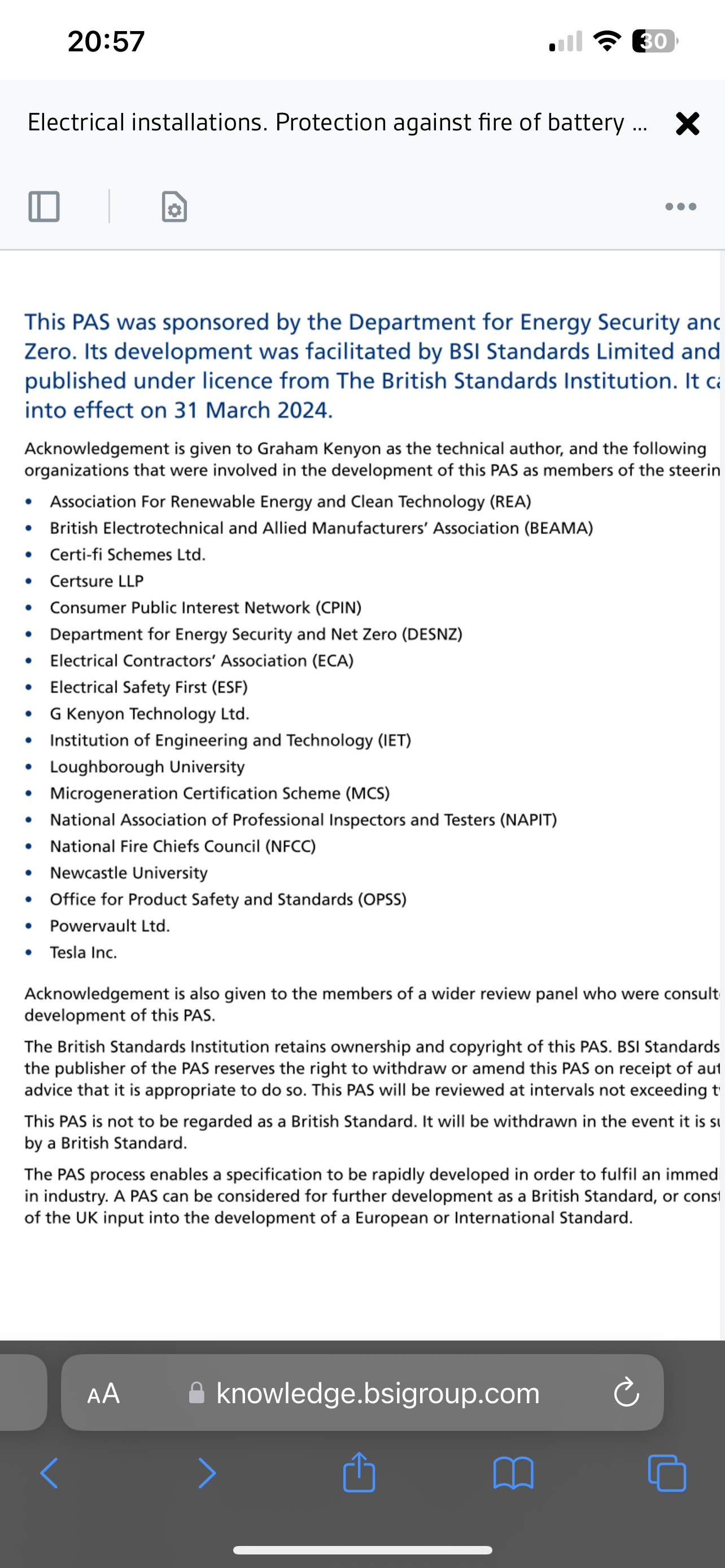Hi everyone not sure if you are aware but some guidance has just been published in the UK about battery locations, while the headlines are mainly around loft installs it goes wider to things such as cell size, tools required in order to detach DC cables ventilation of battery/batteries mono systems, Bartery Monitoring and Management Systems (BMMS) like Victron, it’s more geared to the batteries being a second source of an original fire.
Those of you designing systems now may want to use or design your systems to incorporate as much as you can this paper is only guidance but the paper has big players in the electrical and battery industry that had input into producing this doc so it has weight and you can bet your last pound this is what insurance companies would be using to not pay for anything. Hope this helps you guys and girls out. It’s free to download those of you that want to digest it. Not sure if the devolved governments will take this on but looks like it could be happening.
Here is an overview of the doc
What is PAS 63100:2024 – Protection against fire of battery energy storage systemsabout?
Electrical battery energy storage systems (BESS) are a key part of domestic renewable energy systems and it’s expected there will be a sharp rise in the number of systems being installed in homes.
To help installers manage the fire related hazards associated with BESS, PAS 63100:2024 covers requirements for fire-safe installations.
Who is PAS 63100:2024 – Protection against fire of battery energy storage systems for?
- Suitably competent designers and installers of BESS that forms part of electrical installations; for dwellings and similar simple electrical installations;
- manufacturers of products forming part of the installed BESS; and
- bodies providing independent certification of products, design and installation of BESS.
What does PAS 63100:2024 - Protection against fire of battery energy storage systemscover?
PAS 63100:2024 specifies requirements for fire safety in the installation of small-scale electrical battery energy storage systems (BESS) in domestic dwellings using stationary secondary batteries as the medium for energy storage.
PAS 63100:2024 defines fire safety requirements for the installation of BESS components including:
- physical requirements for battery units;
- battery management;
- power conversion equipment (PCE); and
- fault management and fail-to-safe operation of all control and monitoring functions.
PAS 63100:2024 also covers installation requirements for:
- installation location in respect of safety and external influences that affect fire safety; and
- protection against fire.
The PAS does not cover:
- battery systems with nominal voltages on the AC and/or DC side exceeding low voltage as defined in BS 7671;
- secondary batteries with total capacity not exceeding 150 Wh incorporated into products or systems that are the subject of harmonized or designated standards (e.g. intruder alarm systems, carbon monoxide alarm systems, fire detection and alarm systems, pluggable uninterruptible power systems, portable appliances, audio/video and information technology equipment);
- domestic dwellings exceeding 200 m2 in floor area;
- transportation of batteries;
- systems incorporating second life batteries;
- BESS that use alternative forms of energy storage;
- BESS in high-risk residential buildings; and
- BESS connected before a distributor’s cut-out or a consumer’s meter (collective PEI).
Why should you use PAS 63100:2024 - Protection against fire of battery energy storage systems?
- The provisions in PAS 63100:2024 are intended to reduce the risk of batteries in dwellings becoming a source of ignition, and to limit the impact of a battery fire if one occurs. It helps installers manage the fire safety related hazards associated with electrical energy (battery) storage systems in homes in the UK.
- It helps installers develop their expertise and commitment to safety. This can enhance the installers’ reputation in the eyes of customers.
- A sharp rise is expected in the number of systems being installed. PAS 63100:2024 can help set a robust fire safety benchmark for small scale battery storage installations, increasing user confidence that systems will be safe and will function reliably, effectively and efficiently.
- Environmental protection. PAS 63100:2024can helping maximize the effectiveness of renewable energy technologies such as solar photovoltaic (PV) systems. This in turn contributes to climate mitigation.
- New markets. By supplying a nationally agreed specification for fire safety in the installation of BESS in domestic dwellings, PAS 63100:2024 can help installers enter new markets.
- Risk mitigation. It can help strengthen risk management in association with the use of electrical battery energy storage systems in homes.
Product Details
Descriptors
Electrical installations
Domestic electrical installations
Fire safety
Storage batteries
Dwellings
Specifications
View moreHide
ICS Codes
13.220.01 Protection against fire in general
29.020 Electrical engineering in general
91.140.50 Electricity supply systems
Committee
ZZ/3
International relationships
—
ISBN
978 0 539 28917 6
Publisher
BSI
The orgs, companies and government bodies involved in the steering Group



